History of Space Travel
Learn about the history of humans traveling into space.
The first earthling to orbit our planet was just two years old, plucked from the streets of Moscow barely more than a week before her historic launch. Her name was Laika. She was a terrier mutt and by all accounts a good dog. Her 1957 flight paved the way for space exploration back when scientists didn’t know if spaceflight was lethal for living things.
Humans are explorers. Since before the dawn of civilization, we’ve been lured over the horizon to find food or more space, to make a profit, or just to see what’s beyond those trees or mountains or oceans. Our ability to explore reached new heights—literally—in the last hundred years. Airplanes shortened distances, simplified travel, and showed us Earth from a new perspective. By the middle of the last century, we aimed even higher.
Our first steps into space began as a race between the United States and the former Soviet Union, rivals in a global struggle for power. Laika was followed into orbit four years later by the first human, Soviet Cosmonaut Yuri A. Gagarin. With Earth orbit achieved, we turned our sights on the moon. The United States landed two astronauts on its stark surface in 1969, and five more manned missions followed. The U.S.’s National Aeronautics and Space Administration (NASA) launched probes to study the solar system. Manned space stations began glittering in the sky. NASA developed reusable spacecraft—space shuttle orbiters—to ferry astronauts and satellites to orbit. Space-travel technology had advanced light-years in just three decades. Gagarin had to parachute from his spaceship after reentry from orbit. The space shuttle leaves orbit at 16,465 miles an hour (26,498 kilometers an hour) and glides to a stop on a runway without using an engine.
Space travel is nothing like in the movies. Getting from A to B requires complex calculations involving inertia and gravity—literally, rocket science—to "slingshot" from planet to planet (or moon) across the solar system. The Voyager mission of the 1970s took advantage of a rare alignment of Jupiter, Saturn, Uranus, and Neptune to shave off nearly 20 years of travel time. Space is also dangerous. More than 20 astronauts have died doing their job.
That hasn’t stopped people from signing up and blasting off. NASA’s shuttle program has ended, but private companies are readying their own space programs. A company called Planetary Resources plans to send robot astronauts to the Asteroid Belt to mine for precious metals. Another company named SpaceX is hoping to land civilian astronauts on Mars—the next human step into the solar system—in 20 years. NASA and other civilian companies are planning their own Mars missions. Maybe you’ll be a member of one? Don’t forget to bring your dog.

Space videos
Outer this world, planet earth, calling all earthlings, the milky way, shoot for the stars, what is hubble, how hubble works, read this next, total solar eclipse.
- African American Heroes
Katherine Johnson
- Action and Adventure
Space Explorer
- Terms of Use
- Privacy Policy
- Your California Privacy Rights
- Children's Online Privacy Policy
- Interest-Based Ads
- About Nielsen Measurement
- Do Not Sell My Info
- National Geographic
- National Geographic Education
- Shop Nat Geo
- Customer Service
- Manage Your Subscription
Copyright © 1996-2015 National Geographic Society Copyright © 2015-2024 National Geographic Partners, LLC. All rights reserved

Space Travel

A few hundred years ago, traveling over the Earth’s surface was a risky adventure. Early explorers who set out to explore the New World went by boat, enduring fierce storms , disease and hunger, to reach their destinations. Today, astronauts exploring space face similar challenges.

Space travel has become much safer as scientists have overcome potential problems, but it’s still dangerous. It’s also very expensive. In order for a space shuttle to break free of Earth’s gravity , it has to travel at a speed of 15,000 miles per hour. Space shuttles need 1.9 million liters of fuel just to launch into space. That’s enough fuel to fill up 42,000 cars! Combine the high speed, heat and fuel needed for launching and you’ve got a very potentially dangerous situation.

Re-entering the atmosphere is dangerous too. When a space craft re-enters the atmosphere, it is moving very fast. As it moves through the air, friction causes it to heat up to a temperature of 2,691 degrees. The first spacecrafts were destroyed during re-entry. Today’s space shuttles have special ceramic tiles that help absorb some of the heat, keeping the astronauts safe during re-entry.

Fun Facts about Space Travel for Kids
- One space shuttle launch costs $450 million.
- The German V2 was the first rocket to reach space in 1942.
- In 1947, fruit flies were launched into space. Scientists wanted to see how they reacted to space travel. Later, in 1949, Albert II, a Rhesus monkey went to space. In 1957, the Russian space dog , Laika, orbited the Earth. Scientists wanted to make sure space travel was safe for humans . Sending animals first gave them valuable information about how bodies react to being in space.

- In 1959, the Russian space craft, Luna 2, landed on the moon . It crashed at high speed. Fortunately, it was an unmanned craft with no astronauts inside.
- Russian astronaut, Yuri Gagarin , was the first human in space. He orbited the Earth in 1961.

- In 1963, the first woman, Valentina Tereshkova , entered space.
- The first U.S. spacecraft landed on the moon in 1966.
- On July 20, 1969, Neil Armstrong and Buzz Aldrin became the first men to walk on the moon and return home safely – a journey of 250,000 miles.
- In 1970, Apollo 13 was headed to the moon when an explosion on board caused serious problems. The astronauts fixed the problems with materials they had on hand and returned home safely.
- US astronauts returned to the moon three more times in 1971.
- 1981 marked the first space shuttle that could be used again. Six shuttles have been built since then.
- In 1986, Space Shuttle Challenger exploded shortly after launch, killing all seven astronauts onboard, including school teacher, Christa McAuliffe.
- Since 2000, permanent crews have been living and working in space at the International Space Station .
- In 2001, the first private citizen, millionaire Dennis Tito, toured space. He paid $20 million to spend a week in space.

Learn More All About Space Travel
Check out this cool video all about space travel:
A video about the N.E.X.T. mission for space travel by NASA.
Enjoyed the Easy Science for Kids Website all about Space Travel info? Take the FREE & fun all about Space Travel quiz and download FREE Space Travel worksheet for kids . For lengthy info click here .
Your browser does not support iframes.
Quick links to all the articles...

Get Fun Kids on your new speaker!

Bored? Get the FREE Fun Kids app!

Check out all Fun Kids podcasts

All new Fun Kids Science Weekly
Top 10 facts.
From the Tudors to rocks to fish, we have all the best facts right here!
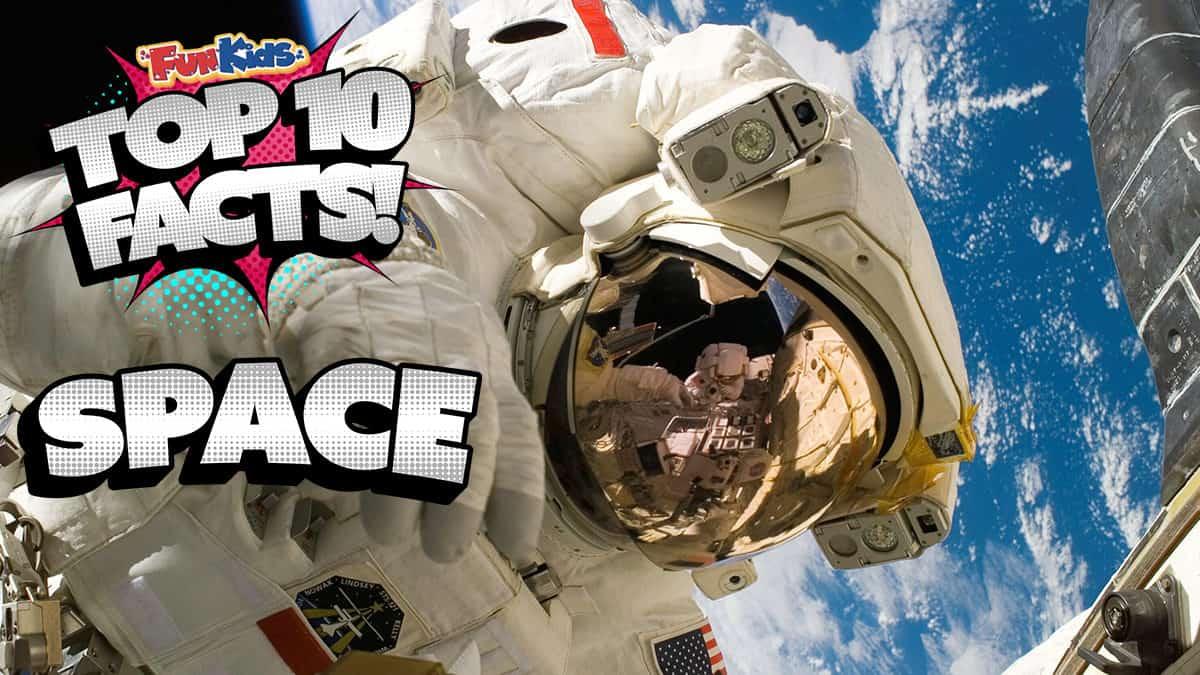
Top 10 Facts About Space!
Do you want to learn about space? Well you've come to the right place! Check out these 10 facts about space...
Space is an incredibly vast and mysterious place, full of fascinating facts and stories. We’ll be exploring the top 10 facts about space. From planets, the Moon, Sun and stars, these facts will give you a better understanding of our place in the universe. So, if you’re ready to take a journey through the stars, let’s get started!
1. The first person on the moon was Neil Armstrong.
The first ever man to step foot on the moon was Neil Armstrong.
It was during the Apollo 11 mission where they were going to attempt to land two men on the moon.
Alongside Neil Armstrong was Buzz Aldrin. They first stepped on the moon on 20th July, 1969.
More to click...
- Win out-of-this-world pyjamas!
- Top 10 Facts About Gold!
- Top 10 Facts About Superheroes!
Neil Armstrong said the famous words “That’s one small step for man, one giant leap for mankind” as he step foot on the moon.
Find out about the jobs in space!
2. The first person in space was Yuri Gagarin.
It must have been very scary to be the first person in space, ever!
The first person to go to space was a man called Yuri Gagarin. He was from Russia.
He went up into space on 12th April, 1961.
Yuri circled the Earth for 108 minutes!
3. For a rocket to get into orbit around Earth, it needs to travel 17,600 miles per hour!
Have you ever seen a rocket take off to go into space?
It has to go REALLY fast!
The rocket will travel 17,600 miles per hour to enable it to orbit around the Earth.
However if you wanted to go even further into space, out of Earth’s gravity, then you would need to travel even faster.
Sometimes up to 25,000 miles per hour!
4. You could fit 1.3 million Earths into the Sun!
The Sun is huge!
In fact, it’s so big you could fit 1.3 million planet Earths inside it!
Watch this video from Deep Space High to find out what space is made of…
5. space is a very cold place at – 270.45 celsius .
Space is very cold and is around -270.45 Celsius.
Luckily space suits are very well insulated to keep the astronauts warm in the cold conditions.
They absorb body heat and then when the body needs warmth, it will release heat. Clever!
6. The Moon reflects light from the Sun.
During the night, the Moon looks really bright!
The light isn’t actually coming from the moon.
The moon reflects the light from the Sun which is why we can see it so clearly.
7. In our solar system there are 8 planets.
In total there are 8 planets. Find out about The Solar System here .
They are Earth, Jupiter, Mars, Mercury, Venus, Saturn, Neptune and Uranus.
Pluto used to be a planet but it got demoted in 2006 and is now known as a dwarf planet.
8. The longest time an astronaut has spent in space is 437 days!
The longest time spent in space is a whole 437 days.
That’s more than a year!
Valery Polyakov holds the record and was up in space from January 1994 until March 1995.
He orbited the Earth 7,000 times and spent his days doing experiments and scientific research.
Find out about the science jobs in space!
9. It is completely silent in space.
Did you know that it is completely silent in space?
There is no way for sound to travel.
Luckily, astronauts can speak using their radios as the radio waves are still able to travel. Phew!
That would be a long few months if they couldn’t speak!
10. A star is a ball of very hot gases.
A star is made up of very hot gases. They are mainly made of hydrogen.
The middle of a star is very, very hot and it gets squeezed by the pressure.
This pressure then makes the hydrogen turn into helium. It makes the star shine really bright.
Did you know the Sun is a star?
It’s just the closest one to Earth which is why it is so big and hot!
Find out what space is made of here!
On the 21st February 2022 we sent YOUR voices to space as part of Mission Transmission.
You can listen to Mission Transmission – our radio broadcast to deep space featuring YOUR voices here .
Send us your favourite facts!
Is there something we've missed? Got a fact you're dying to tell us? Submit it below and we could use it on a future Top 10 Facts page!
Remember to always ask an adult before filling out forms online.
To record a message tap the big red button below. Your browser may ask permission to access the microphone, just accept this.
Leaving Fun Kids?
The History of Space Travel Timeline
Albert II became the first monkey in space on June 14, 1949, in a specially adapted US V2 rocket.
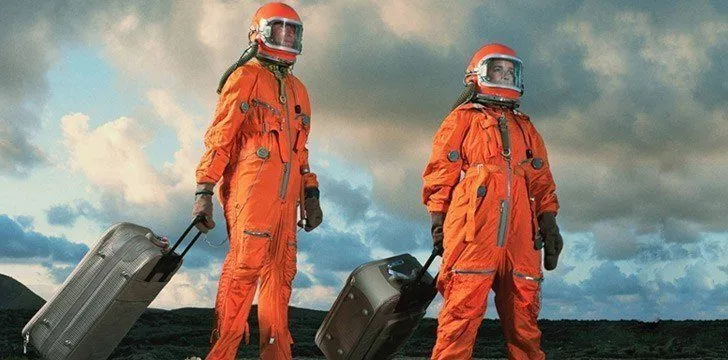
To travel into the unknown of space is a dream for so many children and adults alike, although one that very few will ever reach.
Throughout time so many countries, and now private companies, across the world have tried to create a method of getting in amongst the stars.
It’s even united countries that previously had such strong conflict.
Here we’re going to go through a timeline of the significant moments in the history of space travel, starting way back in the 1940s.
In 1942 the German V2 rocket, designed by Wernher Von Braun, was the first to reach 100km (62 miles) from the Earth’s surface.
Also known as the boundary of space.
Braun later worked with NASA on the rockets that went to the moon.
In 1947, the first animals went into space.
Fruit flies were used to study the effects of space travel on animals as they’re very similar to humans.
The flies traveled with a supply of corn to eat on the flight.
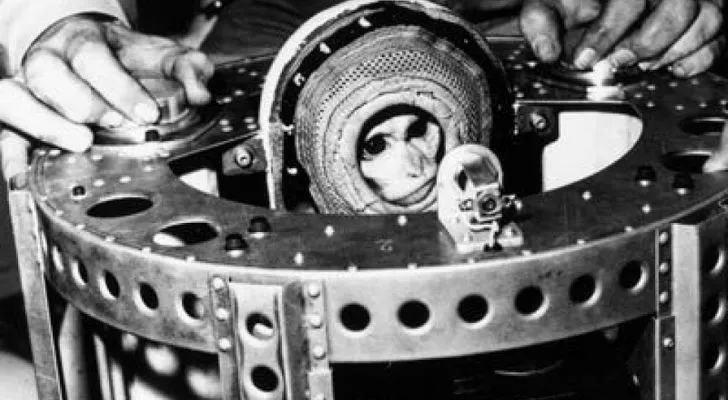
Albert II was the first monkey in space.
Albert II was a Rhesus monkey and boldly went where no primate had been before on June 14 , 1949, in a specially adapted US V2 rocket, that flew 83 miles from Earth.
On October 4 , 1957, Russia launched the first space satellite (or sputnik in Russian) named Sputnik 1.
Sputnik 1 was the first satellite in orbit around the earth.
In November the same year, Laika the Russian dog became the first animal to orbit the earth. Laika is Russian for “Barker”.
She traveled in Sputnik 2 and helped understand whether people could survive in space.
By 1959 Both US and Russian scientists were in a race to get a craft to the Moon; the Russians won.
Space-probe Luna 2 crash-landed into the moon at fatal speeds.
Ten years later, the first human visited the surface.
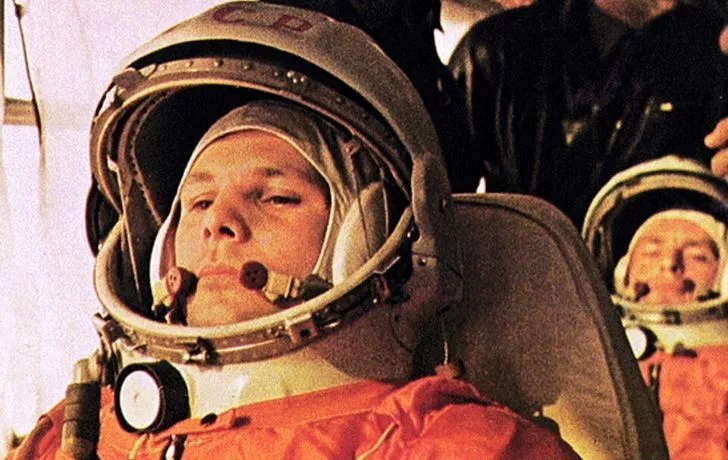
On April 12, 1961 , Russian Cosmonaut Yuri Gagarin became the first man in space.
Traveling in Vostok 1 he completed one orbit of the earth, landing about two hours after launch.
Gagarin had to eject and use a parachute to land as the craft was designed to crash land.
John Glenn became the first US man to orbit the Earth aboard the Friendship 7.
John actually chose this name; officially the craft is called the Mercury-Atlas 6, for the mission Mercury and it being the 6 th flight to use the faster Atlas rocket.
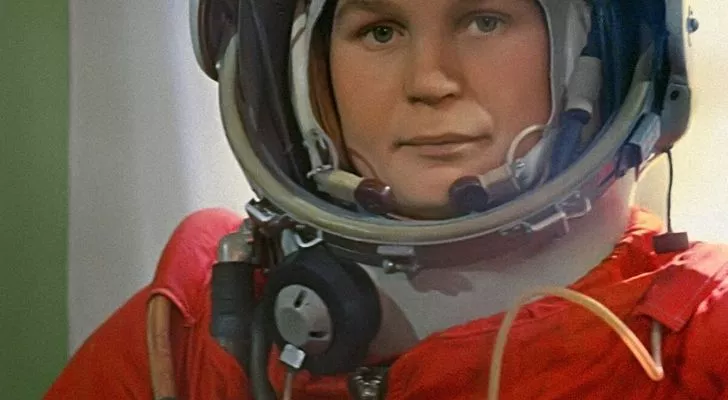
Valentina Tereshkova, a Russian cosmonaut, became the first woman in space.
After her mission, she had a crater on the far side of the Moon is named after her.
Who could believe, after just sending men to the moon, NASA managed to successfully conduct the first Mars flyby with their Mariner 4 craft.
In 1963 John F. Kennedy promised that by 1970 the US would have put men on the moon.
NASA firstly sent a robot spaceship called Surveyor 1, to make sure they could safely land.
It reached the moon on May 30 , 1966, just after the Russian probe Luna 9.
Once Surveyor 1 landed it took photographs and sent them back to eagerly awaiting scientists who used them to visualize the terrain and work out a plan to land people on the moon safely.
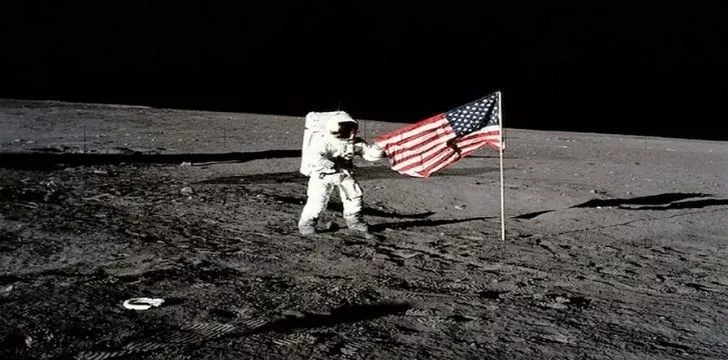
On July 20 , 1969, the famous “one small step” was taken by Neil Armstrong and Buzz Aldrin, and the first words were spoken, “the Eagle has landed”.
This iconic phrase confirmed them as the first men on the moon.
The Apollo 11 craft flew them 250,000 miles to the moon and back.
Apollo 13 on April 13, 1970 , the second day of its trip to the moon, suffered a wiring fault causing an explosion.
Using what was on board, NASA and the astronauts on board made repairs to bring the damaged craft back to Earth.
This saw the first use of the Lunar Rover, an electric vehicle with a top speed of 8 mph (13 kph), to explore the moon on the fourth, fifth and sixth Apollo missions.
The rover took Boeing 17 months to design and develop.
The first-ever space station was launched in 1971, the Russian Salyut 1, and was launched from an unmanned rocket.
In 1973 Mars 2, a 2-part Russian probe explored Mars .
One part was to stay in orbit for the whole year sending pictures back to earth and the other was to land and explore Mars’ surface.
It was destroyed when a parachute failed.
The US launched their Voyager 1 deep space probe.
Voyager 1, on February 17, 1998 , became the most distant human-made object in space after it passed the previous title holder; Pioneer 10.
From April 12, 1981, saw the idea of reusable space crafts, prior to this they were a one-hit-wonder.
The Space Shuttle was designed to lower costs and could be used up to 100 times.
With five rocket motors, it reached 17,000+ mph (27,350+ Kph). Six were built and 2011 saw their last use.
The first craft to start the Space Shuttle era was called Columbia.
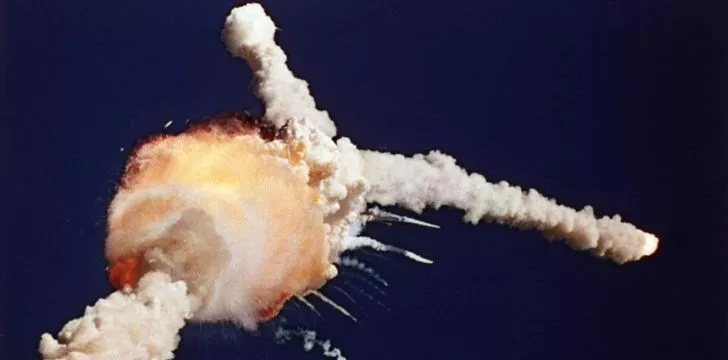
On January 28, 1986 , Space Shuttle Challenger exploded due to a fuel system failure just after launch.
All seven astronauts were killed.
After this tragedy, all shuttles were grounded for almost three years.
In the same year, Construction started on the MIR space station, the first consistently inhabited long-term space station.
It was built in sections, taking 10 years, with each bit rocket-launched and combined in orbit.
In 2001 it was destroyed on its descent to earth. The ISS or International Space station also started construction in this year designed for research and space exploration.
The final major module of the ISS didn’t arrive until 2010.
The shuttle Discovery was launched to deploy the Hubble Space Telescope into Earth’s Orbit.
The telescope is able to lock onto a target without moving to about the width of a human hair seen a mile away, or more scientifically, more than 7/1000 th of an arcsecond.
Just like there are 60 minutes in an hour, there are 60 arcminutes in 1 degree, and 60 arcseconds in an arcminute.
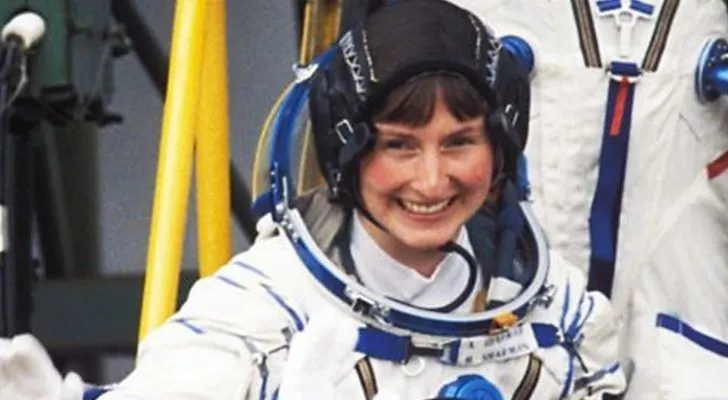
In 1989, Helen Sharman won a competition to become the first British astronaut in space, she previously worked for Mars Bar.
After 18 months of harsh training, she joined a Russian mission to the MIR space station.
After all their problems, the US and Russia finally start working together, or at least in space terms they were.
This year saw the US shuttle Atlantis dock at the Russian MIR space station.
The first look at mars occurred when Sojourner, A U.S rover, travels onto Mars to explore the planet’s geology.
In 2000 the first permanent crew inhabited the International Space Station (ISS), and have been there ever since.
On April 28, 2001 , US millionaire Dennis Tito spent around $20,000,000 and had 900 hours of training to be the first space tourist for a ride in a Russian Soyuz spacecraft.
He spent one week in orbit and of this time he spent most visiting the ISS.
This symbolized the hopes for space travel, for it to become a normal venture one day for everyone.
On June 21 , 2004, the first privately funded manned space flight happened with the craft SpaceShipOne.
An adaptation of this technology is being used by Virgin Galactic, a company offering private tourist flights into space.
Even though in 2014 it crashed during testing, flights are still happening.
In this year, the European Space Agency launched their Rosetta probe hoping to reach Comet 67P/Churyumov–Gerasimenko.
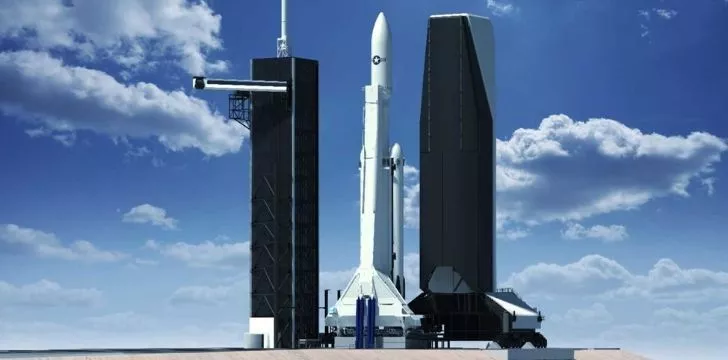
SpaceX, a private company that built a craft to replace the newly retired Space Shuttle, became the first to launch a privately funded liquid-fueled rocket into Orbit, the Falcon 1.
These rockets are used to launch their Dragon capsule, a remote-controlled capsule that takes supplies to the ISS.
The U.S Messenger mission to Mercury , launched in 2004, made its journey successfully traveling 48 million miles (77 million km), to begin its yearlong orbit of the mysterious planet.
Russia launched the largest space telescope to date named Spekt-R beating the Hubble.
The device is built to study astronomical objects with an angular resolution of a few millionths of an arcsecond.
The colossal telescope weighed 11,000 pounds (5,000 kilograms).
A major moment for commercial space travel started on May 22 nd , SpaceX launched another Dragon C2+ powered by their Falcon 9 rocket to deliver a resupplying capsule to the ISS.
The capsule was caught by the ISS’s robotic arm and docked for nearly six days while astronauts removed cargo and loaded that destined for Earth, a trip it made with no real complications.
NASA’s Curiosity rover, a piece of equipment the size of a car, landed on Mars on August 6 th .
It’s the largest and most advanced rover ever to land on the red planet.
On August 25 th , Voyager 1, launched in the late ‘70s, became the first man-made spacecraft to cross into interstellar space.
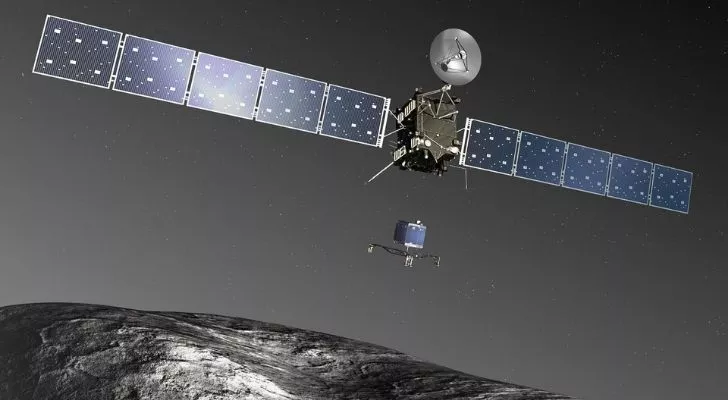
The Rosetta probe, launched in 2004, finally reached Comet 67P/Churyumov–Gerasimenko after a 4 billion-mile journey.
Whilst on the comet, the lander sent data and high-resolution images from the Comet’s surface back to earth including 490-foot cliffs and house-sized boulders.
The Philae lander made a soft landing on November 12 th after a perilous 7-hour descent.
Harpoons designed to attach to the comet failed, and the lander bounced twice before landing successfully.
On March 6 th , NASA’s Dawn spacecraft entered an orbit around a dwarf planet Ceres, the largest object in the asteroid belt between Mars and Jupiter .
With a 590 mile (950 km) diameter, it makes up a quarter of the mass of the belt.
July 14 th saw NASA’s New Horizons spacecraft arrive at Pluto after traveling 9 years and 4.6 billion miles.
It passes, during its closest approach, only 7,750 miles from the surface and took high-resolution photos of Pluto and Charon, the largest moon.
Pluto is said to be about 50 miles larger than thought.
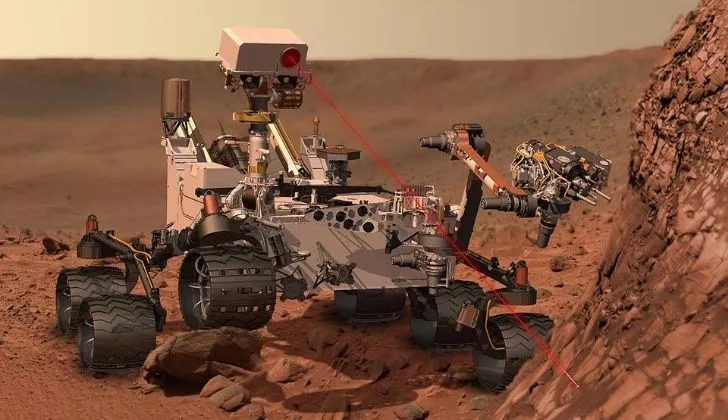
On July 30 , 2020, at 11:50 UTC, NASA launched their Mars Rover, which was the largest of four missions to Mars in 2020 .
Without a doubt, this mission plans to be the most fruitful with the craft equipped with state-of-the-art modern technology and engineering capable of truly exploring the martian land like never before!
The Mars Rover’s mission among other things is to see if the red planet has ever accommodated extra-terrestrial life by exploring any signs of habitable conditions both in the past and present.
Space travel has for so many people mesmerized them from a very young age, myself included, and as this list has shown, there is always something new to discover!
We have barely scratched the surface, and yet every year we learn or launch something new with the dream of reaching some unknown bit of the universe.
To travel to the furthest edge man can reach will always be the aim.
To unearth the secrets hidden, to find life or anything that’s interesting and bewildering drives some of the best minds in the world every day.
- Space Kids - Space History
- Hubblesite.org
- NASA - Mission Status

Related Posts
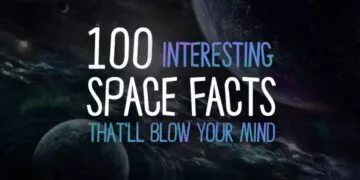
100 Interesting Space Facts That’ll Blow Your Mind
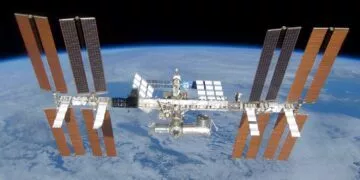
10 Incredible Facts About The International Space Station
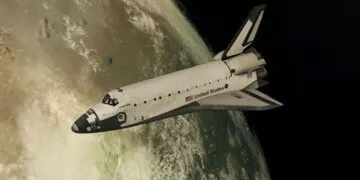
26 Facts About Space Shuttles That Are Outta This World!
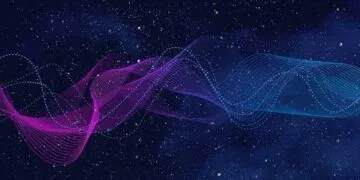
Is Space Completely Silent?
About the author.

Dan Lewis has worked in the tech sector for about 7 years and is qualified in most areas including networking, hardware, software & support. Enjoys writing about anything techy, nerdy or factually interesting.
Popular Today
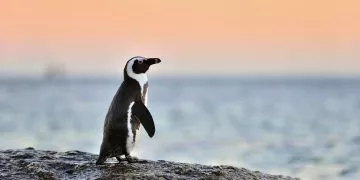
April 25: Facts & Historical Events On This Day

20 Facts About Daisies & Sweet Peas, April’s Birth Flowers

22 Fabulous Facts About Thursday

20 Awesome Facts About April
We have a thorough fact-checking process and a dedicated team verifying our content for accuracy. But occasionally, we may get things wrong, or information becomes outdated. If you believe something to be incorrect, please leave us a message below.
Leave a Comment
Latest facts.
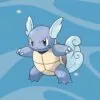
15 Wild Facts About Wartortle | Pokémon
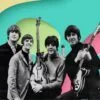
20 Facts About the Beatles That Won’t Let You Down

15 Enchanting Facts About Estonia

National Pet Day | April 11
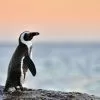
The Fact Site is the number one source for the most interesting & random facts about animals, celebrities, food, films, games & so much more. You will learn something about everything!
Popular Facts Lists
1000 Interesting Facts
100 Random Fun Facts
100 Mind Blowing Facts
100 Strange But True Facts
100 Interesting Space Facts
Popular Pages
2024 Events & Facts
Big Questions
Today In History
World Records
Information
Privacy Policy
The Fact Shop

Published by DK Children
Learn all about the Sun, our Solar System, the International Space Station, how to be an astronaut, the Space Race, and whole new worlds discovered by space-exploration probes in this exciting children's space travel book. Packed with inspiring stories and facts about exploring space, astronauts, and the first Moon landing. DKfindout! Space Travel is ideal for school projects and for children who love to learn about adventures in space. From the first astronaut in space to the Apollo Moon landings, this book is packed with exciting facts about the astronauts who explored space, including Yuri Gagarin's first journey into space and Neil Armstrong's Moon landing. This beautifully illustrated children's book is crammed with amazing facts that will delight young readers and is written by experts and checked by an educational consultant. Part of the award-winning DKfindout! series, this exciting book includes amazing photography and illustrations that help children understand the wonders of space travel.
Related products and resources
Sign up to a FREE DK Learning account to access recommended books, teaching resources, and more
- About Us About DK Learning Contact Us Careers at DK Terms & Conditions Privacy Policy & Cookies
- More from DK DK.com English for Everyone English for Everyone Junior Phonic Books

- DIGITAL MAGAZINE
MOST POPULAR
Neil Armstrong facts!
Check out our ten top facts about neil armstrong….
Learn about the first man who walked on the Moon in our 10 amazing Neil Armstrong facts…
Neil Armstrong facts
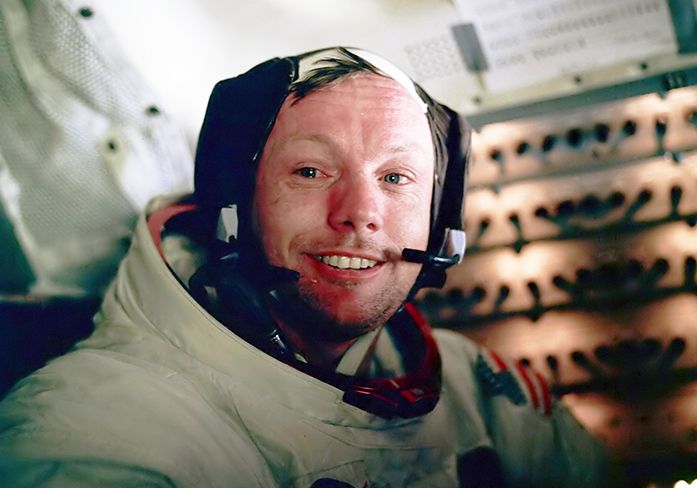
Full name: Neil Alden Armstrong Date of birth: 5 August 1930 Hometown: Wapakoneta, Ohio, U.S.A. Occupation: Astronaut, military pilot, professor Died: 25 August 2012 Best known for: Being the first human to walk on the moon
1) Neil Armstrong was the first human to walk on the moon during the NASA (National Aeronautics and Space Administration) Apollo 11 mission on 20th July 1969. He completed the mission alongside co-pilots Edwin E. “Buzz” Aldrin and Michael Collins .
2) When Neil was a child growing up in rural America, he loved to learn all about aeroplanes and space . He got his student pilot’s licence when he was just 16 — before he even learned to drive a car!
3) When Neil was 17, he went to university to study aeronautical engineering — the science used in the designing, building and testing of aircrafts. Clever!
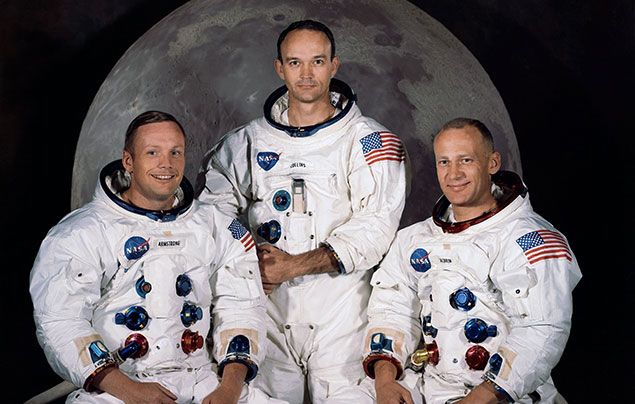
3) Around the world, more than half a billion people watched the Moon Landing. When Neil stepped foot on the moon for the first time, he said the now famous line, “That’s one small step for man, one giant leap for mankind.”
4) Neil walked a distance of about 60 metres on the surface of the moon —that’s roughly the length of 11 Asian elephants!
5) The rocket that launched Neil and his crew into space – the Saturn V rocket – was as tall as a 36-storey building! The Launch Control Center – which housed the team of people responsible for overseeing the launch from the ground – was situated 3.5 miles from the launch pad itself.
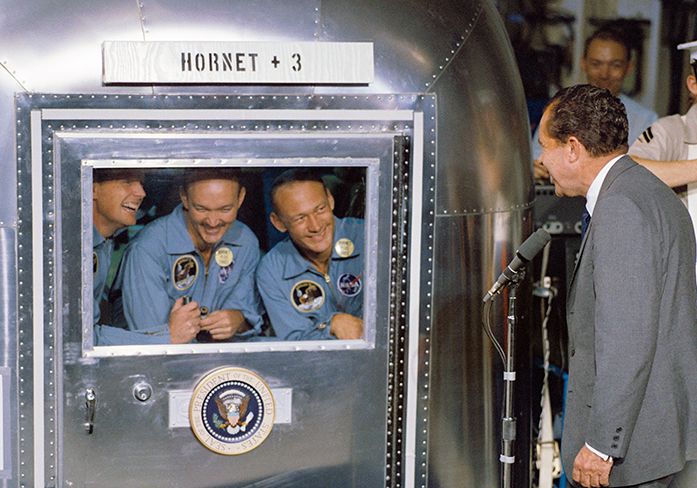
6) The Lunar Module that Neil and Buzz piloted together to land on the moon was called the Eagle . It’s where the now famous saying, “The Eagle has landed” , comes from!
7) Not only were Neil and Buzz the first humans to step foot on the moon, but they were also the first humans to view Earth from the moon’s surface. Neil said that while there, he could hold up his thumb and block out the Earth ! He said that the Moon felt lonely, but that it made him realise just how beautiful our home is.
8) When Neil and his co-pilot, Buzz, were on the moon, they collected dust materials from the moon’s surface to study back on Earth. In 2017, the samples were sold at auction for £1.4 million — wow !
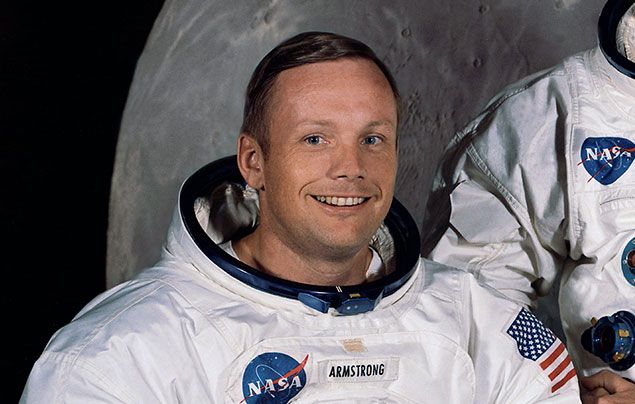
9) Neil was considered a great American hero , but a reluctant hero, too. After the Apollo 11 Mission, Neil only stayed with NASA for a further two years. He found the press attention exhausting, and decided that he wanted to be a teacher of engineering in his home state of Ohio. He never returned to life in the spotlight.
10) Neil won many awards, including the Presidential Medal of Freedom in 1969, the Hubbard Medal in 1970, the Congressional Space Medal of Honor in 1978 and the General James E. Hill Lifetime Space Achievement Award . Sadly, Neil died in 2012, but the progress that he made for space travel and our understanding of the Moon is still remembered today!
Image credits: GPA Photo Archive, U.S. Department of State (Public Domain).
Did you enjoy reading our amazing neil armstrong facts let us know by leaving a comment below, leave a comment.
Your comment will be checked and approved shortly.
WELL DONE, YOUR COMMENT HAS BEEN ADDED!
this helped a lot thank you
I loved this it helped me with my homework
i love learning about neil armstrong.
Interesting
This really helped in my project for school!
this was the most 2 best one ever seen.
hi i am tim
Cool LOL!!!
gooooooooooooooooooooooooooooooooooooooooood
Enjoyed reading about Neil Armstrong.
This really helped me for my speech of Neil armstrong THANKS!
As a student doing a project on Neil Armstrong this helped alot
this is cool
this is really going to help me on my project
very intresting
[…] Neil Armstrong Facts- National Geographic Kids […]
[…] https://www.natgeokids.com/uk/discover/science/space/neil-armstrong-facts/ […]
[…] Here are some facts https://www.natgeokids.com/uk/discover/science/space/neil-armstrong-facts/ […]
liked this website
amazing wok dudes
My sister and her husband has to work for the week so we will
interesting
Wow so cool ahhhhh
The specs are real cool
Give some more interesting facts
i want to go to the moon some day .and i leart a lot about neil armstrong and his crew i leart alot at school to about the first man on the moon thank you so much for shareing this article
Cool, i like Neil Armstrong, Michael Collins and Buzz Aldrin. :)
My favourite astronaut is Neil Armstrong.
Awesome! Really Helped Me!
Awesome it must have been awesome on the moon!
space :) :) :)
neil looks like my uncle
LETS EAT THE MOON ITS CHEES RIGHT?
I love you I wish I could see you
can i have help
The facts are really cool!!
it was really cool
this website is cool!
this is one of the most interesting sites I have seen!
When you are faithful you can touch anything it work
AMAZING! (I knew it already but I want to here more)
I love this website. I love learning new things. This is good for any person with a desire for knowledge.
I like the moon I want to go there
amazing. Lets go Neil
Wooooooooooooooooow
interesting facts
the moon is so cool
wow i want to go on the moon.
you know how I love the best
I love space
I enjoyed so much reading this article, that I didn't want it to finish. Thank you for sharing!
At school we are learning about space. It is really fun
there are very interesting facts on this page!!!!!!!!!!
Very interesting, i've learnt about this man.
I enjoyed so much reading this article, that I didn't want it to finish. Thank you for sharing! BR, Preslav
Wow that’s amazing
Great work, love what you are doing. Keep it up x
Really interesting! Learned a lot!
I did not know that Neil was a person
I learnt all about Neil and buzz when I was 5!!!
They are my favourite characters!
I learnt about Neil and Buzz already!
CUSTOMIZE YOUR AVATAR
More like space.
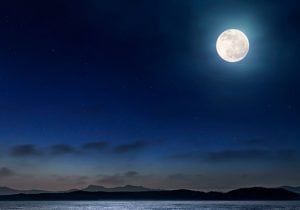
The Phases of the Moon

Female astronaut sets super space records!
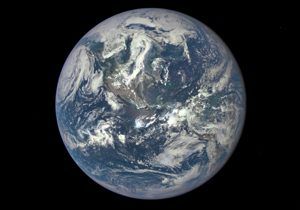
Facts about the Earth

Tim Peake interview!

Sign up to our newsletter
Get uplifting news, exclusive offers, inspiring stories and activities to help you and your family explore and learn delivered straight to your inbox.
You will receive our UK newsletter. Change region
WHERE DO YOU LIVE?
COUNTRY * Australia Ireland New Zealand United Kingdom Other
By entering your email address you agree to our Terms of Use and Privacy Policy and will receive emails from us about news, offers, activities and partner offers.
You're all signed up! Back to subscription site
Type whatever you want to search
More Results

You’re leaving natgeokids.com to visit another website!
Ask a parent or guardian to check it out first and remember to stay safe online.

You're leaving our kids' pages to visit a page for grown-ups!
Be sure to check if your parent or guardian is okay with this first.

IMAGES
VIDEO
COMMENTS
Explore the life of the man who was the first person to land on the Moon. KS1 The World Around Us Space learning resources for adults, children, parents and teachers.
The first person to walk on the moon was an American called Neil Armstrong. In 1969 he took part in an exciting mission known as Apollo 11. They landed their spaceship on the moon and walked ...
History of Space Travel. Learn about the history of humans traveling into space. The first earthling to orbit our planet was just two years old, plucked from the streets of Moscow barely more than a week before her historic launch. Her name was Laika. She was a terrier mutt and by all accounts a good dog. Her 1957 flight paved the way for space ...
The International Space Station (ISS) is an artificial satellite. At about the size of a football pitch from end-to-end, it is the biggest object ever flown in space. It is as big inside as a ...
This history of space travel KS1 PowerPoint contains 10 slides, including an introductory slide and an ending slide. The 8 slides in between are packed with useful information about the history of space travel, spanning the launch of the very first rocket in 1942 to the European Space Agency's Solar Orbiter taking pictures of the Sun in 2020. Each slide presents a segment of the timeline ...
The major reason for space travel is to avoid being hit by a big rock from space. Last Halloween the asteroid 2015 TB145 did not hit the Earth… it missed by 480,000km - which is just a little more than the distance from Earth to the Moon. The asteroid was about 600m across, and moving at a speed of 126,000km/h!
Pupils will have the opportunity to consider the history and future of space travel using our National Geographic Kids' Space primary resource sheet. The teaching resource can be used in study group tasks, as a printed handout for each pupil, or for display on the interactive whiteboard. Activity: Ask children to imagine they are going on a ...
KS1 - Events beyond living memory that are significant nationally or globally. • KS1 - They should know where the people and events they study fit within a chronological framework. • KS1 - To identify similarities and differences between ways of life in different periods. Science 1 Go on a materials hunt in the classroom and learn to ...
Today's space shuttles have special ceramic tiles that help absorb some of the heat, keeping the astronauts safe during re-entry. In 1957, the Russian space dog, Laika, orbited the Earth. Fun Facts about Space Travel for Kids. One space shuttle launch costs $450 million. The German V2 was the first rocket to reach space in 1942.
This history of space travel KS1 PowerPoint contains 10 slides, including an introductory slide and an ending slide. The 8 slides in between are packed with useful information about the history of space travel, spanning the launch of the very first rocket in 1942 to the European Space Agency's Solar Orbiter taking pictures of the Sun in 2020. Each slide presents a segment of the timeline ...
Space Exploration. Do you know any of the planets that can be found in our Solar System? Well, there are eight altogether - Mercury, Venus, Earth, Mars, Jupiter, Saturn, Uranus and Neptune. These ...
What sort of people are suitable for space travel, and what skills do they need? ... Extreme machines - the conquest of air and space In the conquest of air and space, there have been many incredible aircraft and spacecraft invented that pushed the boundaries of flight- this page is a guide to a few of the most interesting and important.
The teaching resource can be used in study group tasks for learning about space and the solar system; as a printed handout for each pupil to review and annotate; or for display on the interactive whiteboard using the images included in the resource for class discussion. Activity: Ask the children to make a solar system display for the classroom ...
How does the Earth orbit and rotate? 21m video. Lesson . 4
Check out these eight awesome images taken from outer space! Life as an astronaut primary resource. Discover what it takes to become a real life astronaut ... Understand more about our solar system with these fun facts! Neil Armstrong primary resource. Discover who Neil Armstrong was and how he became the first man to step foot on the Moon
Find out about The Solar System here. They are Earth, Jupiter, Mars, Mercury, Venus, Saturn, Neptune and Uranus. Pluto used to be a planet but it got demoted in 2006 and is now known as a dwarf planet. 8. The longest time an astronaut has spent in space is 437 days! The longest time spent in space is a whole 437 days.
World Space Week, 4-10 October annually, is a chance to explore our 'out of this world' space-themed resources for primary and secondary schools. You might also use these resources for Mars Day ...
Here we're going to go through a timeline of the significant moments in the history of space travel, starting way back in the 1940s. 1942. In 1942 the German V2 rocket, designed by Wernher Von Braun, was the first to reach 100km (62 miles) from the Earth's surface. Also known as the boundary of space.
Published: 06 Feb 2019. Size: 187 x 240mm. Pages: 64. £5.99. Buy from retailer. About DKfindout! Space Travel. Learn all about the Sun, our Solar System, the International Space Station, how to be an astronaut, the Space Race, and whole new worlds discovered by space-exploration probes in this exciting children's space travel book.
The First American Into Space. Before anyone had even dreamed of a smartphone or flat-screen TV, people were traveling to space. It was the 1950's, and the United States was in a race. We aren't ...
Neil in his (at the time) state-of-the-art NASA spacesuit — without the helmet! Full name: Neil Alden Armstrong Date of birth: 5 August 1930 Hometown: Wapakoneta, Ohio, U.S.A. Occupation: Astronaut, military pilot, professor Died: 25 August 2012 Best known for: Being the first human to walk on the moon 1) Neil Armstrong was the first human to walk on the moon during the NASA (National ...
BBC Teach > Primary Resources > KS1 Science A group of children aged five and six, and their families, marvel at the wonders of space. These clips are taken from the original BBC series, Little ...
That's why there's no sound in space. For sound to travel it needs air molecules to vibrate. In deep space there's no air. ... Foundation and KS1 in Northern Ireland and Early and 1st Level in ...